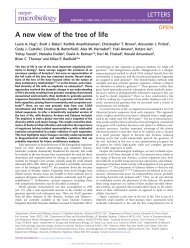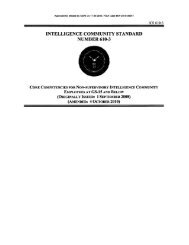The Joint Force in a Contested and Disordered World
JCS-JOE-2035
JCS-JOE-2035
Create successful ePaper yourself
Turn your PDF publications into a flip-book with our unique Google optimized e-Paper software.
from adversaries, as opposed to counter<strong>in</strong>g the United States on a technology-by-technology <strong>and</strong><br />
platform-by-platform basis. “Moreover, rapid globalization <strong>and</strong> diffusion of technology has<br />
lowered the barriers for [even] smaller states…to acquire <strong>and</strong> field advanced military capabilities<br />
or <strong>in</strong>expensive but highly effective asymmetric capabilities such as robotic swarms.” 26<br />
Accelerat<strong>in</strong>g efforts by adversaries to apply a variety of new technologies will threaten to frustrate<br />
the <strong>Jo<strong>in</strong>t</strong> <strong>Force</strong>’s ability to close from strategic <strong>and</strong> operational distances.<br />
<strong>The</strong> future <strong>Jo<strong>in</strong>t</strong> <strong>Force</strong> will be challenged to break the power projection capabilities of adversary<br />
states, <strong>in</strong>clud<strong>in</strong>g modern mechanized forces on l<strong>and</strong> <strong>and</strong> sophisticated naval forces at sea, all<br />
protected by advanced aerospace <strong>and</strong> electromagnetic jamm<strong>in</strong>g <strong>and</strong> spoof<strong>in</strong>g capabilities.<br />
Furthermore, a number of adversaries will <strong>in</strong>vest <strong>in</strong> hypersonic weapons, <strong>and</strong> the first nation to<br />
successfully deploy an operational system will ga<strong>in</strong> significant military advantages due to the<br />
speed at which targets can be engaged. Functional hypersonic systems will ultimately provide a<br />
regional strike capability which might potentially disrupt <strong>Jo<strong>in</strong>t</strong> <strong>Force</strong> power projection.<br />
Context 4: Disrupted Global Commons<br />
Prosperity of the United States depends upon its largely uncontested ability to access <strong>and</strong> use the<br />
global commons, which consist of those areas that “belong to no one state <strong>and</strong> that provide access<br />
to much of the globe.” 27 <strong>The</strong> commons <strong>in</strong>cludes spaces at sea <strong>and</strong> <strong>in</strong> the air outside of a state’s<br />
territorial waters (generally def<strong>in</strong>ed as 12 miles from a coastal basel<strong>in</strong>e), <strong>and</strong> outer space<br />
(particularly <strong>in</strong> orbit from 60 to 22,300 miles above the surface of the Earth). Additionally, the<br />
electromagnetic spectrum – particularly access to signals for communications, position,<br />
navigation, <strong>and</strong> tim<strong>in</strong>g – must be considered part of the commons. 28 Open <strong>and</strong> accessible global<br />
commons are the pillars of the current <strong>in</strong>ternational economy <strong>and</strong> empower states that use them to<br />
conduct commerce, transit, scientific study, or military surveillance <strong>and</strong> presence. In 2035, the<br />
United States will f<strong>in</strong>d itself challenged <strong>in</strong> parts<br />
of the global commons as states <strong>and</strong> some nonstate<br />
actors assert their own rules <strong>and</strong> norms<br />
with<strong>in</strong> them. 29<br />
Character of Conflict<br />
“S<strong>in</strong>ce men live upon the l<strong>and</strong> <strong>and</strong> not upon the sea, great issues between nations at war<br />
have always been decided—except <strong>in</strong> the rarest cases—either by what your army can do<br />
aga<strong>in</strong>st your enemy’s territory <strong>and</strong> national life, or else by the fear of what the fleet makes<br />
it possible for your army to do.” 30<br />
26<br />
Shawn Brimley, Ben FitzGerald <strong>and</strong> Kelly Sayler, “Game Changers: Disruptive Technology <strong>and</strong> U.S. Defense<br />
Strategy” Center for a New American Security Disruptive Defense Paper (September 2013).<br />
27<br />
Barry Posen, “Comm<strong>and</strong> of the Commons: <strong>The</strong> Military Foundation of U.S. Hegemony,” International Security,<br />
Vol. 28, No. 1 (Summer 2003), Posen attributes the orig<strong>in</strong> of the term to Alfred Thayer Mahan, who described the<br />
sea as “a wide common, over which men may pass <strong>in</strong> all directions.” <strong>The</strong> Influence of Sea Power upon History:<br />
1660-1783. (Boston: Little, Brown <strong>and</strong> Co., 1890), p. 25, while the Accord<strong>in</strong>g to the United Nations Environment<br />
Program (UNEP), global commons are “doma<strong>in</strong>s that lie outside the political reach of any one nation state.”<br />
28<br />
This context deliberately excludes cyberspace, which is described <strong>in</strong> detail <strong>in</strong> Context 5: A Contest for<br />
Cyberspace, on page 36.<br />
29<br />
Scott Jasper (ed.) Conflict <strong>and</strong> Cooperation <strong>in</strong> the Global Commons (2012). p.2.<br />
30<br />
Julian Corbett, Some Pr<strong>in</strong>ciples of Maritime Strategy. (1918), p. 12.<br />
30











